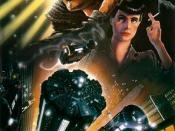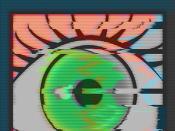At first glance, the film, "Blade Runner," appears to be just another science fiction film featuring alien beings. However, deeper study and contemplation reveals a myriad of important semiotic and cultural nuances that unveil a great deal about our society and us.
Ridley Scott's 1982 film, "Blade Runner" takes place in the year 2019 in Los Angeles. The "alien of choice" in this film is the replicant. Created by man in human form, the replicant, while actually more perfect that a human, is designed to die in exactly four years from the date of its creation. Replicants were produced to serve as slaves in cosmic "off-worlds." In an attempt to counteract their oppression and increase their life span, a group of replicants stole a spaceship and returned to earth where they proceeded to kill many humans and search for their maker. Because of the murder of humans, the replicants were banned from earth and any that were identified were to be killed or "retired" as quoted in the film.
Identifying the replicant was indeed a daunting task, because replicants so closely resembled humans. Thus, one is forced to consider what makes a human actually human, as opposed to a replicant, which is considered a non-human? In the movie, the mission was accomplished via a test designed to detect changes in eye movement. In real life, one cannot help but wonder if our society may be actually illogically analyzing individuals for alienness versus humanness based upon a set or rules; or perhaps religious belief, hatred or fear? Wendy Leeds-Hurwitz' work, "Semiotics And Communications: Signs, Codes, Cultures" is an excellent resource for understanding both the practical and less practical functions of semiotics and the study of semiotic behavior. This was helpful in terms of understanding the nuances interrelated with this film. "In each case, whether it be a traffic signal or poetic imagery, something (the sign) conveys meaning-meaning that would not otherwise be obvious, or that we could not otherwise present in such a condensed form" (1). This was clearly evident in the film. The most remarkable sign was the release of a white dove by a replicant, as he said, "It's time to die." White doves are a traditional symbol of peace. This is especially telling because, up until that very moment, which was near the end of the movie, the replicants behaved more like hawks, a symbol that is traditionally associated with aggressive action.
Throughout the film, the replicants actively and aggressively tried to circumvent their predetermined death date through any and all means. Included was a visit to their maker with demands for a longer life. It was here that the replicant learned that absolutely nothing could be done to deactivate the built-in death timer. The maker had, in fact, tried and failed. The maker had fashioned the best possible creation, but even it was not gifted with eternal life. Clearly there is a direct figurative connotation here between replicants and humans. From a faith-based symbolic prospective, although humans are the finest of our Maker's creations, even we cannot live forever.
Having studied Tom Bottomore's paper, "Alienation," I saw parallels between the film and Karl Marx's conception of alienation. The impoverished, human-like replicants were alienated from the larger, more powerful, wealthier human segment of society. Even their most basic needs, such as food and shelter were not entirely met, thus they had no hope or opportunity of achieving economic independence. The replicants' aggressive behavior was due, in part, to the disparity between replicant and human social orders, which had been calculatedly established by humans. Throughout the film, the replicants attempt to narrow the gap and blend in with the more desirable human social order. Non-verbal and verbal signs are effectively utilized to convince humans that they themselves are human, and to gain humans' trust.
The reading that made the most sense to me, in terms of intended implicit or metaphorical meaning surrounding the alien in this particular film, was "Aliens, Alien Nations, and Alienation in American Political Economy and Popular Culture" by Ronnie D. Lipschutz. Per Lipschutz, "Aliens are usually treated as a threatening presence, as a force that, if not stopped, will absorb or consume the body politic." (2) This theme was present throughout the film, and it is prevalent in today's society. Lipschutz postulates that, "Replicants force us to ask what makes someone human?" If we substitute the word "aliens" in place of "replicants," and consider the definition of alien as someone who is not native to our country, one cannot help but see the current social implication significance.
Works Cited Leeds-Hurwitz, Wendy. "Semiotics And Communications: Signs, Codes, Cultures." Hillsdale, NJ: Lawrence Erlbaum Associates, 1993: 3-21 Lipschutz, Ronnie D. "Aliens, Alien Nations, and Alienation in American Political Economy and Popular Culture." Santa Cruz, CA.
Works Consulted Agnew, Derek. Dystopia: Representation of Technology in Futuristic Cinema. 2003.
Bottomore, Tom. "Alienation". From: The Dictionary of Marxist Thought. Cambridge, Massachusetts: Harvard University Press. 1983: 9/15.





